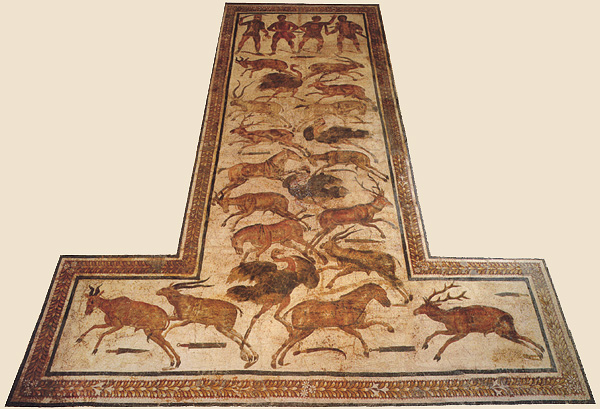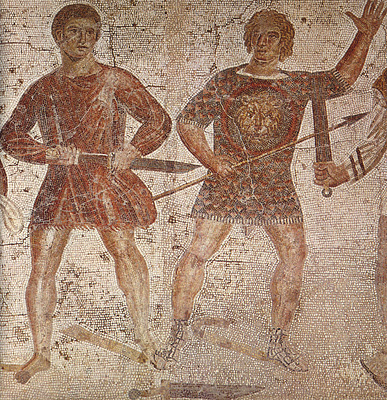
In this mosaic from the mid-third century AD (Sousse, Tripoli), panicked deer, wild asses, ostriches, and antelopes run about the arena, as four venatores prepare for the slaughter. The hunters below wear short tunics and one carries a spear, with other weapons scattered in the sand.

As the number of exotic animals became increasingly scarce and their cost concomitantly higher, more common species were displayed. The price edict of Diocletian, promulgated in AD 301, set a maximum price for goods and services, including wild animals, in an unsuccessful attempt to curb inflation and stabilize prices. Two categories of sizes for each species were distinguished. Among the carnivores, there were lions (125,000 to 150,000 sesterces), lionesses (100,000 to 125,000), leopards (75,000 to 100,000), and bears (20,000 to 25,000). (In the arena, itself, a prime lion had a maximum cost of 600,000 sesterces, a lioness, 400,000.) Herbivores included ostriches (5,000 sesterces), wild boars (4,000 to 6,000), deer (2,000 to 3,000), and wild asses (5,000).
The edict also indicates the tariff charged for transport. For a wagon pulled by oxen, which could haul twelve-hundred pounds, the rate was twenty denarii (eighty sesterces) per mile. With agricultural and urban development, and the destruction of natural habitat, wild animals were forced into more remote areas, making their capture and transportation that much more expensive.
In AD 384, Theodosius, too, tried to control how much was expended on the games (Codex Theodosianus, XV.9.1), and Symmachus wrote to the emperor in appreciation.
"When disgraceful ostentation had brought ruin to senatorial office because of reckless expenditure, you restored ancient sanity to our habits and costs, so that giving a modest show does not now bring stigma to colleagues who cannot afford more, nor does thoughtless extravagance bankrupt those who out of shame try to do more than they can afford" (Letters, X.8).
As animals became more difficult and expensive to acquire, there also was the disapproval of the church, although less because of the cruelty to the animals or the brutalizing effect of the spectacle than the danger to human life. In AD 469, Leo prohibited public entertainments on Sundays (Codex of Justinian, III.12.9.2) and, although the emperor Anastasius banned the venationes altogether in AD 498, wild beast shows continued, although rarely, early into the sixth century. Cassiodorus, writing for the emperor Theodoric (Varia, V.42), conveyed permission for a venatio in AD 523, the last one recorded in Rome, while the last one in Constantinople occurred in AD 537.
Although these enormous costs still could be paid, it became increasingly difficult to find sufficient numbers of animals, especially as aristocrats competed for prestige in surpassing what had gone before. Symmachus, urban prefect of Rome in the late fourth century AD, in preparing for games to be given in the name of his son in AD 393 and AD 401, complained that "I must now outdo the reputation earned by my own shows" (Letters, IV.6).
In 1855, the English botanist Richard Deakin cataloged 420 species of grasses, flowers, weeds, and trees found at the Colosseum. Most of the seeds were native to Italy, but some were so exotic that they only could have been deposited from the gut of animals brought from Africa and Asia.
Reference: Mosaics of Roman Africa: Floor Mosaics from Tunesia (1996) by Michèle Blanchard-Lemée, Mongi Ennaïfer, Hédi Slim, and Latifa Slim; Mosaïques de Tunisie (1976) by Georges Fradier and André Martin; The Colosseum (2000) edited by Ada Gabucci; The Story of the Roman Amphitheatre (2000) by D. L. Bomgardner; The Decline of the Ancient World (1966) by A. H. M. Jones; Animals for Show and Pleasure in Ancient Rome (1937) by George Jennison; Death and Renewal: Sociological Studies in Roman History (1983) by Keith Hopkins; Porphyrius the Charioteer (1973) by Alan Cameron; Flora of the Colosseum of Rome (1855) by Richard Deakin. Regrettably, the letters of Symmachus have not been translated into English.